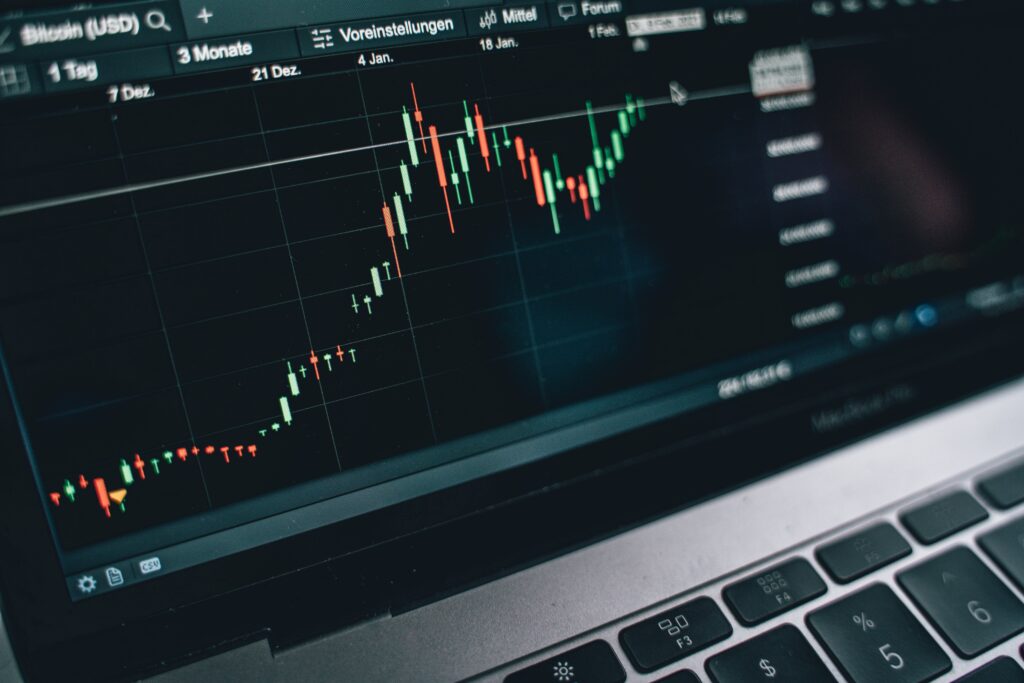Technical Analysis Tools and Indicators
Understanding the Basics of Moving Averages in Crypto Trading

Moving averages are a fundamental analytical tool used in crypto trading. They provide valuable insights into market trends and help traders make more informed decisions. To understand moving averages, it’s crucial to grasp the idea of an average price over a specified period.
The most common type of moving average is the Simple Moving Average (SMA). It calculates the average price by summing up a specific number of closing prices and then dividing it by that same number. For example, if we want a 10-day SMA, we add up the closing prices of the last 10 days and divide that sum by 10.
Another type is the Exponential Moving Average (EMA). It assigns greater significance to recent price data by weighting them more heavily. This gives the EMA a faster response to market changes compared to the SMA.
Moving averages have multiple purposes in crypto trading. Firstly, they help identify trends and determine whether prices are moving up, down, or remaining flat. When the trend is upward, it implies bullish momentum, while a downtrend indicates a bearish sentiment.
Additionally, moving averages assist in filtering out fluctuations and noise caused by short-term market volatility. By smoothing out price data over time, traders can obtain a clearer picture of overall market direction.
Moving averages are frequently utilized to identify support and resistance levels. When prices approach a moving average from below and find support, it suggests potential buying opportunities as traders anticipate a rebound. Conversely, if prices test an established moving average from above and get rejected, it may indicate a resistance level that could signal sell opportunities.
Crossovers between different moving averages can generate trading signals. For instance, when a shorter-term moving average crosses above a longer-term one, it generates a bullish signal, while the opposite indicates bearish sentiment.
The choice of moving average period largely depends on personal preferences and trading strategies. Shorter periods yield more sensitive averages that react quickly to price changes; hence they may be suitable for day traders. Conversely, longer periods result in smoother averages that offer a broader view of market trends and might be preferred by swing or long-term investors.
Moving averages, however popular, have certain limitations. Like any technical indicator, they are not flawless and can generate false signals during volatile or unpredictable market conditions. Therefore, traders often combine moving averages with other indicators and tools to improve their decision-making process.
Understanding the basics of moving averages is a significant step forward in crypto trading analysis and decision making. Whether it’s identifying trends, filtering noise, spotting support and resistance levels, or generating crossover signals, these simple yet powerful tools enhance market understanding and can greatly contribute to profitable trading strategies.
The RSI Indicator: How to Use It Effectively in Your Crypto Trading Strategy

The RSI indicator, also known as the Relative Strength Index, is a popular tool used by traders to analyze price movements and identify potential trading opportunities in the crypto market. It is an oscillating momentum indicator that measures the speed and change of price movements, providing insights into whether a cryptocurrency is overbought or oversold.
To understand how to effectively use the RSI indicator in your crypto trading strategy, you should start with the basics. The RSI is typically depicted as a line graph that fluctuates between a value of 0 and 100. Values above 70 are generally considered overbought, suggesting a potential reversal or correction might occur soon. On the other hand, values below 30 are often seen as oversold, indicating a possible uptrend.
One aspect to consider while using the RSI indicator is divergences. Divergence occurs when the price of a cryptocurrency moves in the opposite direction to the RSI reading. For instance, if the price of a crypto asset continues to rise while the RSI is decreasing, it could suggest a trend reversal might be pending.
Another way to enhance your trading strategy with the RSI is understanding support and resistance levels. By analyzing price movements relative to these levels, you can create more informed buy or sell decisions. For example, if the RSI indicates that a cryptocurrency has hit an oversold level around major historical support, it might be an excellent opportunity to consider going long on that asset.
Moreover, understanding bullish and bearish signals signal an ability to capitalize on market fluctuations. Bullish divergence appears when the price decreases during oversold conditions, but the RSI creates higher lows. This indicates weakening selling pressure and might signal a potential buying opportunity depending on other market factors.
Conversely, bearish divergence happens when an asset’s price rises during overbought conditions, yet the RSI generates lower highs. As selling pressure weakens or increasing buying momentum slows, this can be taken as a potential sell or short-selling signal, albeit not one to rely on solely.
The duration and timeframe for applications of RSI vary widely. Shorter timeframes may provide more frequent signals but can also lead to increased false positives. Conversely, larger timeframes may give fewer opportunities but with higher accuracy. It’s vital to experiment with different time periods and backtest your strategy before committing capital.
It’s essential to remember no indicator works flawlessly all the time. The RSI is just one tool in your trading toolkit and should be complemented by additional analysis and indicators. Always consider other aspects such as market trends, candlestick patterns, volume, and fundamental analysis when crafting your trading strategy.
In summary, the RSI indicator is a valuable tool for crypto traders interested in analyzing price movements and identifying potential opportunities in the market. Understanding how to interpret RSI readings, spot divergences, analyze support and resistance levels, and recognize bullish or bearish signals can elevate your trading strategy and improve decision-making abilities. Remember to use the RSI in conjunction with other tools and indicators to drive better trading outcomes.
MACD – Deciphering the Signals for Crypto Market Movements

The Moving Average Convergence Divergence (MACD) is a popular technical analysis indicator used to decipher signals for crypto market movements. It is particularly helpful for traders and investors in understanding the trends and potential momentum shifts in the cryptocurrency market.
Essentially, MACD is composed of two moving averages plotted on a chart: the MACD line and the signal line. The MACD line is calculated by subtracting the 26-day Exponential Moving Average (EMA) from the 12-day EMA, while the signal line represents a 9-day EMA of the MACD line itself.
The interpretation of MACD revolves around its crossover points. When the MACD line crosses above the signal line, it generates a bullish signal suggesting potential upward movement in prices. Conversely, when the MACD line crosses below the signal line, a bearish signal is generated, indicating possible downward price movement.
One commonly used technique to identify trends with MACD is to observe divergences. If there is a bullish divergence, where the price creates lower lows but the MACD line forms higher lows, it can indicate an upcoming trend reversal or potential buying opportunity. Conversely, a bearish divergence occurs when the price reaches higher highs while the MACD line makes lower highs, indicating a possible trend reversal or selling opportunity.
Another aspect of MACD that traders consider is its histogram, which portrays the difference between the MACD line and the signal line. When positive bars are formed above the zero line, it implies increasing bullish momentum; conversely, when negative bars are formed below the zero line, it signifies increasing bearish momentum.
Additionally, traders often look for specific patterns in MACD to take trading decisions. One such pattern is called a bullish or bearish crossover. A bullish crossover occurs when the MACD line moves above its signal line, providing potential buy signals. In contrast, a bearish crossover happens when the MACD line drops below its signal line, creating sell signals.
It’s important to note that the accuracy of MACD signals depends on various factors and may not be foolproof. Therefore, many traders use MACD in combination with other technical indicators or tools to increase the probability of making accurate predictions.
In conclusion, MACD is a widely utilized indicator for analyzing crypto market movements. Its crossover points, divergences, histogram, and specific patterns provide valuable insights for traders seeking to identify potential opportunities in the cryptocurrency market while managing their risk effectively.
Bollinger Bands: Timing Your Buy and Sell in Cryptocurrency

Bollinger Bands: Timing Your Buy and Sell in Cryptocurrency
If you are involved in cryptocurrency trading, one tool that can significantly help you make better trading decisions is the Bollinger Bands. This technical indicator, developed by John Bollinger, serves as a useful guide for determining when to buy or sell cryptocurrencies based on price volatility.
So, what exactly are Bollinger Bands? Well, they consist of three lines plotted on a price chart – a simple moving average (SMA) line at the center, and two outer bands called the upper band and lower band. These bands dynamically adapt to market conditions by measuring asset price fluctuations over a defined period.
The middle line (SMA) represents the average price of the cryptocurrency over a specific time frame. It acts as an anchor, providing insights into the trend direction. The upper band reflects volatility and signifies that prices could be overbought. Conversely, the lower band indicates prices could be oversold due to increased volatility.
The idea behind Bollinger Bands is to identify potential buying or selling opportunities by analyzing patterns within the bands. For example, if the cryptocurrency’s price stays consistently near or touches the upper band, it might indicate an overbought condition, suggesting that selling could be imminent. Conversely, when the price hugs the lower band or approaches it closely, it may signal an oversold condition and possibly a good time to buy.
Beyond just indicating overbought and oversold conditions though, Bollinger Bands can also show periods of consolidation. When the bands’ distance narrows, it suggests decreasing market volatility or lateral movement within a certain price range. Traders should prepare for a potential breakout and possible significant changes in price trends.
Aside from identifying entry and exit points, traders can also use Bollinger Bands in conjunction with other indicators such as Relative Strength Index (RSI) or Moving Average Convergence Divergence (MACD) to increase the probability of accurate trading signals. Additionally, pattern recognition techniques can be applied to help identify chart formations such as triangles, reversals or breakouts, combined with Bollinger Bands.
It’s worth mentioning that no indicator guarantees 100% accuracy in predicting price movements; the market is always subject to unexpected turns. It is crucial to consider other factors such as fundamental analysis, news events, and broader market trends when making your trading decisions.
In conclusion, Bollinger Bands serve as a powerful tool in timing your buy and sell decisions within the cryptocurrency market. By monitoring price volatility and identifying overbought or oversold conditions, traders can gain valuable insights about potential entry or exit points. Remember to complement this indicator with other technical analysis tools while being aware of overall market conditions to maximize your trading success.
Fibonacci Retracement Levels: Finding Entry and Exit Points in Crypto Markets
Fibonacci retracement levels are an essential tool used in technical analysis to help traders determine potential entry and exit points in the crypto markets. Named after the famous mathematician Leonardo Fibonacci, this method involves the use of horizontal lines which correspond to key levels obtained through mathematical calculations.
To apply Fibonacci retracement levels, a trader initially identifies a significant price movement on a chart representing a cryptocurrency’s price action. This movement may be either an upward or downward trend, known as swings or waves. These swings can vary in length and are quantified using Fibonacci ratios, mainly 23.6%, 38.2%, 50%, 61.8%, and 78.6%.
Once the swing has been identified, the trader procedurally draws a line from the start of the swing to its end, marking these two points as 0% and 100% respectively. Subsequently, using the Fibonacci ratios mentioned above, parallel horizontal lines are drawn and marked on the chart at these respective percentages with respect to the length of the swing.
The resulting retracement levels then act as potential support or resistance areas where price reversals or continuing trends are likely to take place. When prices retrace or reverse back towards any of these levels, traders often pay close attention as these zones offer valuable insights.
In uptrends, fib retracement levels may be interpreted as buying opportunities. Traders often attempt to enter a position when cryptocurrencies’ prices drop to one of these levels since they indicate potential support areas. If price analysis shows bullish signals such as candlestick patterns or positive indicators, traders might consider it an optimal time to buy or increase their holdings.
Conversely, during downtrends, fib retracement levels might signal potential points for selling or shorting since they act as resistance zones where heightened selling pressure could emerge. If prices approach one of those levels accompanied by bearish reversal signals like bearish candlestick patterns or negative indicators, traders may view it as a suitable moment to sell or take profits.
Aside from entry and exit decisions, Fibonacci retracement levels can also help identify potential target levels within an ongoing trend. If prices break through the immediate retracement level, traders might look for subsequent fib extension levels such as 161.8% or 261.8% as possible profit-taking targets.
However, it’s important to note that Fibonacci retracement levels should never be solely relied upon for making trading decisions. They should always be used in conjunction with other technical analysis tools and indicators to validate signals. Analyzing both short-term and long-term trends, along with considering factors like market sentiment or news, is crucial for successful trading in the dynamic world of cryptocurrencies.
Ichimoku Clouds: A Comprehensive Guide for Crypto Traders

Ichimoku Clouds, also known as Ichimoku Kinko Hyo in Japanese, is a comprehensive technical analysis indicator that has gained popularity among crypto traders. Created by Goichi Hosoda in the late 1930s, this powerful tool provides valuable insights into the market trends, support and resistance levels, and potential reversals. In this comprehensive guide, we will delve into the various components of Ichimoku Clouds and how traders can effectively use it in the crypto market.
- Tenkan-sen (Conversion Line):
The first component of Ichimoku Clouds is the Tenkan-sen or Conversion Line. This line represents the average of the highest high and lowest low over a specific period, usually nine periods. It provides a tightly bound moving average that reacts quickly to short-term price movements. - Kijun-sen (Base Line):
The Kijun-sen or Base Line follows a similar approach to the Conversion Line but over an extended time frame, usually 26 periods. It offers a slightly lagging moving average than Tenkan-sen, providing traders with a mid-term perspective. - Senkou Span A (Leading Span A):
Using the average of Tenkan-sen and Kijun-sen plotted forward by 26 periods, Senkou Span A forms one edge of the cloud or “Kumo.” This leading span helps identify potential support and resistance areas in future price movements. - Senkou Span B (Leading Span B):
Similar to Senkou Span A, the Senkou Span B calculates an average over a distinct period (usually 52), but it is plotted forward by 26 periods. The area between Senkou Span A and B creates the other edge of the cloud. The width reflects market volatility. - Kumo (Cloud):
The cloud component of Ichimoku is formed by Senkou Span A and Senkou Span B. Traditionally, a green-colored cloud represents a bullish market sentiment, while a red cloud signifies a bearish sentiment. This feature serves as a dynamic support or resistance zone, enabling traders to gauge potential reversals. - Chikou Span (Lagging Span):
The Chikou Span, or Lagging Span as the name suggests, lags behind the current price by 26 periods. It helps confirm signals generated by other components of Ichimoku, acting as a momentum indicator when it breaks above or below recent candlestick patterns.
By considering the interactions between these different components and analyzing their relative positions in real-time charts, crypto traders can leverage Ichimoku Clouds to identify potential buy or sell signals. When the price moves above the cloud, it indicates bullish market conditions, while a move below suggests bearish momentum. Moreover, when the Conversion Line crosses above the Base Line within the cloud and both are moving upward, it generates a bullish signal; similarly, their bearish crossing within the cloud with downward movement generates a sell signal.
Traders should also focus on the cloud thickness since thicker clouds indicate stronger support or resistance levels. Additionally,rushing price movements through Kumo can provide valuable insights into potential trend continuation or reversals.
While mastering Ichimoku Clouds might take time and practice, incorporating its analysis effectively can greatly improve trading decisions in the volatile world of cryptocurrencies. Therefore, prudent utilization paired with other complementary analysis tools enhances traders’ understanding and potentially increases profitability in navigating cryptomarkets.
Stochastic Oscillator: Identifying Overbought and Oversold Conditions in Cryptocurrency Markets

The Stochastic Oscillator is a popular technical indicator used in cryptocurrency markets to identify overbought and oversold conditions. It was developed by George Lane in the 1950s and has since gained wide recognition among traders for its effectiveness.
In essence, the Stochastic Oscillator compares an asset’s closing price to its trading range over a specified timeframe. The indicator consists of two lines, %K and %D, which fluctuate between 0 and 100. %K represents the most recent closing price’s position within the trading range, while %D is a moving average of %K.
By analyzing these lines, traders can gauge whether an asset is overbought or oversold. When %K rises above a certain predefined threshold, usually 80, and then crosses below %D, it suggests that the asset is overbought and a potential sell signal might be approaching. Conversely, when %K falls below another threshold, often 20, and then crosses above %D, it indicates oversold conditions and potentially implies a buy signal.
The primary idea behind the Stochastic Oscillator is that after prolonged uptrends or downtrends, prices tend to revert to their mean value before continuing their trajectory. It helps traders identify potential turning points in the market, helping inform their buy or sell decisions. However, it is essential not to solely rely on this indicator but use it in conjunction with other technical analysis tools for more accurate predictions.
Traders often adjust the input parameters of the Stochastic Oscillator to suit their trading style and preferences. For instance, altering the number of periods considered while calculating the indicator may make it more or less sensitive to price movements.
Overall, the Stochastic Oscillator provides valuable insights into momentum and potential trend reversals in crypto markets. Efficient utilization of this indicator can assist traders in identifying overbought and oversold conditions, enhancing their decision-making process while navigating through volatile cryptocurrency markets.
The ATR Indicator: Assessing Crypto Market Volatility for Better Trade Decisions

The Average True Range (ATR) indicator is a widely used tool in the realm of technical analysis, specifically for assessing market volatility in the crypto market. As an essential component of a trader’s toolkit, ATR aids in making better trade decisions by providing insights into market conditions.
ATR measures the volatility of a cryptocurrency or any other market instrument based on its historical price data. The primary purpose of this indicator is to determine the average range at which prices move, indicating the level of volatility during a specific period. Traders can then utilize this information to analyze potential risks and rewards associated with specific asset trades.
The calculation behind the ATR indicator involves sampling high-to-low price range values over a chosen number of periods, usually 14 or 21 days. It accounts for any gaps between trading sessions and depicts the true price range by factoring in these irregularities. The resulting values are expressed in the form of absolute price units, revealing the current level of volatility.
A higher ATR value indicates greater volatility, suggesting that prices have experienced wider fluctuations over recent periods, thus highlighting increased risk. Conversely, a lower ATR value suggests calmer and relatively stable market conditions.
One way to interpret the ATR data is through comparative analysis. By contrasting the ATR values of different cryptocurrencies on various timeframes, traders can determine which ones exhibit higher or lower levels of volatility. This insight helps traders make informed decisions when choosing potential assets for trading activities.
The ATR indicator is also valuable for assessing potential stop-loss and take-profit levels for trades. By analyzing historical price data along with respective ATR values, traders can establish appropriate levels for safeguarding against adverse price movements while also considering profit targets.
Furthermore, the ATR indicator allows traders to adapt their strategies based on changing market conditions. During times of heightened volatility, suitable adjustments can be made by taking into account the augmented risks inherent in volatile environments. Traders may consider either widening their stop-loss distance or allocating smaller positions to mitigate potential losses.
In essence, the ATR indicator acts as a reliable and effective tool for assessing volatility in the crypto market. By providing key insights into price movements, it empowers traders to make optimal decisions when executing trades, managing risks, and establishing realistic profit expectations. No wonder it has found widespread utility among crypto market participants.
Candlestick Patterns Every Crypto Trader Should Know: A Visual Guide to Market Sentiment

Candlestick patterns are vital tools that every crypto trader should know about when analyzing market sentiment. These patterns, represented by graphical shapes on a price chart, provide insights into the emotions and psychology of market participants.
- Bullish Engulfing Pattern:
- – This pattern indicates a potential trend reversal from bearish to bullish.
- – It consists of a small bearish candle followed by a larger bullish candle that completely engulfs the previous candle’s body.
- – Indicates buyer dominance over sellers, suggesting the possibility of an uptrend.
2. Bearish Engulfing Pattern:
- – The opposite of the bullish pattern, the bearish engulfing pattern signals a potential trend reversal from bullish to bearish.
- – It comprises a small bullish candle followed by a larger bearish candle that engulfs the previous candle’s body.
- – Suggests that sellers are taking control and a downtrend might follow.
3. Hammer Pattern:
- – Generally occurs during a downtrend and marks a possible reversal towards an uptrend.
- – Consists of a small body with a long lower wick and little to no upper wick.
- – Signifies that buyers stepped in to push prices back up after a significant sell-off when market sentiment was negative.
4. Shooting Star Pattern:
- – Opposite of the hammer pattern, shooting star appears during an uptrend and implies a potential reversal towards a downtrend.
- – Identified by a small body with a long upper wick and little to no lower wick.
- – Shows that sellers entered the market during an upward movement, highlighting a possible shift in sentiment.
5. Doji Pattern:
- – A doji occurs when the opening and closing prices are almost identical, resulting in its cross-like appearance.
- – Symbolizes market indecision or a balanced standoff between buyers and sellers.
- – May indicate that current trends may be ending or undergoing a transition.
6. Morning Star Pattern:
- – A three-candle pattern appearing after a downtrend.
- – The first is a bearish candle, followed by a small bullish or bearish candle with a gap below the first, and then a larger bullish candle.
- – Suggests a reversal from a downtrend to an uptrend, indicating the emergence of buying pressure.
7. Evening Star Pattern:
- – The opposite of the morning star, it occurs during an uptrend.
- – Comprises of a bullish candle followed by a small bullish or bearish candle with a gap above the first, and then a larger bearish candle.
- – Implies a potential reversal from an uptrend to a downtrend, highlighting the entrance of selling pressure.
Understanding these visual representations of candlestick patterns in cryptocurrency price charts can assist traders in predicting potential market reversals and interpreting prevailing market sentiment. Regular analysis of these patterns can provide valuable insights into market dynamics.
Volume Analysis in Cryptocurrency Trading: Understanding Market Strength

Volume analysis is a crucial aspect of cryptocurrency trading that helps traders determine market strength and make informed decisions. Simply put, volume refers to the overall number of trading activity within a specific period. By evaluating volume, traders can gauge the level of investor interest in a particular cryptocurrency.
Analyzing volume provides insights into market movements and trend reversals. When volume increases significantly, it often accompanies notable price movements, indicating strong buying or selling pressure. Conversely, low volume suggests a lack of substantial market interest and potential instability.
Traders use various technical indicators to analyze volume. One widely used tool is the Volume Weighted Average Price (VWAP), which calculates the average price weighted by volume throughout a trading day. VWAP helps traders identify fair value prices and understand whether a security is overbought or oversold.
Another popular indicator is On-Balance Volume (OBV), which tracks the cumulative volume in relation to the price direction. If the OBV line rises steadily, it suggests stronger buying pressure, indicating bullish sentiment. Similarly, if the OBV line falls consistently, it indicates stronger selling pressure and bearish sentiment.
The analysis of volume can also help identify trend confirmations or divergences. For example, when prices rise alongside increasing volume, it confirms an uptrend’s strength. However, if the prices rise but accompanying volume decreases or remains stagnant, it suggests weakness and a possible trend reversal.
Additionally, analyzing volume can aid in spotting market manipulation or significant shifts in investor sentiment. Sudden spikes in volume during consolidation periods may precede major price movements driven by significant buy or sell orders. Recognizing such patterns allows traders to position themselves advantageously.
Using multiple timeframes to analyze volume can offer more comprehensive insights. Looking at daily, weekly, and monthly volume data enables traders to understand changing trends on different scales, from short-term momentum to long-term market sentiment.
Moreover, comparing current trading volumes with historical data allows for relative assessments, giving traders context about whether the current activity is above or below average. This approach helps identify periods of accumulation or distribution and assists in recognizing potential breakouts or reversals.
In conclusion, volume analysis is a key component of successful cryptocurrency trading, enabling traders to interpret market strength and plan their investments accordingly. Understanding volume patterns assists in identifying market sentiment changes, confirming trends, and unveiling potential opportunities for profit. By incorporating volume analysis into their trading strategies, cryptocurrency traders can make well-informed decisions based on concrete data rather than relying solely on price movements.
How to Combine Different Technical Indicators for a Robust Crypto Trading Strategy

Combining different technical indicators is an effective approach to develop a robust crypto trading strategy. Adding up multiple indicators allows traders to reduce false signals, increase the overall accuracy of predictions, and make more informed decisions. Here are some fundamental concepts to help you understand how to combine these indicators effectively:
Trend Confirmation: One popular technique is to combine trend indicators to validate market trends. Tools such as Moving Averages (MAs), Bollinger Bands, or Trendlines can be used together. By corroborating the signals produced by each of these indicators, traders can gain stronger confirmation of a trend direction.
Momentum and Oscillators: Combining momentum indicators, like the Relative Strength Index (RSI), with oscillators such as the Moving Average Convergence Divergence (MACD), can provide valuable insights into market conditions. For instance, if RSI indicates overbought levels while MACD displays bearish convergence, it suggests an impending trend reversal.
Support and Resistance Levels: Combining support and resistance tools like Fibonacci retracement levels, Pivot Points, and horizontal price lines can enhance trading decisions. When these levels align with other technical indicators indicating a potential trend change, it strengthens the validity of a trade signal.
Volume Analysis: Incorporating volume indicators, such as the On-Balance Volume (OBV) or Volume Weighted Average Price (VWAP), helps evaluate price movements in relation to trading volume. Higher volume at specific price levels could suggest significant support or resistance points.
Divergence Analysis: Divergence occurs when an indicator disagrees with the current price action. By fusing tools like the Stochastic Oscillator or Relative Strength Index with other indicators, you can identify divergences indicating potential trend reversals before they happen.
Pattern Recognition: Using different technical analysis patterns along with appropriate indicators enriches your understanding of market behavior. For example, combining candlestick patterns like Doji or Hammer with suitable moving averages and oscillators helps detect potential trend reversals or continuations.
It’s essential to note that a comprehensive understanding of individual technical indicators and their interaction is crucial while combining them. Traders should also consider the overall market context, news events, and risk management strategies.
Remember, every trading strategy carries inherent risks, as the market can be unpredictable. Thoroughly test and fine-tune your strategy on historical data before applying it to live trading. With experience, skill, and a strong understanding of technical analysis, combined indicator systems can greatly improve your crypto trading decisions.
Chart Patterns That Matter in Cryptocurrency Trading: Triangles, Head and Shoulders, Flags and Pennants

Chart patterns play a crucial role in understanding and predicting price movements in the cryptocurrency market. Three of the most significant chart patterns that matter in cryptocurrency trading are triangles, head and shoulders, and flags and pennants.
Triangles: Triangles are consolidation patterns that indicate a temporary balance between buyers and sellers. They are categorized into three types: ascending, descending, and symmetrical triangles. Ascending triangles exhibit a flat top trendline and a rising bottom trendline, signaling potential bullishness. Descending triangles possess a downward sloping top trendline and a horizontal bottom trendline, indicating possible bearishness. Symmetrical triangles present converging trendlines without any discernible slope, indicating indecision in the market.
Head and Shoulders: The head and shoulders pattern is a bearish reversal formation characterized by three distinct peaks. The first and third peaks (the shoulders) are lower in height than the center peak (the head), forming a visual pattern similar to a human’s head and shoulders. This chart pattern often indicates a trend reversal from bullish to bearish when it breaks below the neckline.
Flags and Pennants: Flags and pennants are shorter-duration continuation patterns that usually emerge after a sharp price movement. A flag pattern consists of two parallel trendlines: one representing the flagpole (the steep price movement) and the other as the flag itself (a period of consolidation). Bullish flags slope against the prevailing price trend, while bearish flags slope in favor of it. Pennants are similar to flags but have converging trendlines rather than parallel ones.
Why They Matter: These chart patterns matter because they can offer traders essential information about potential future price movements. Understanding these patterns aids in identifying breakout or breakdown points, confirming trend reversals, or recognizing the consolidation phase before resuming an existing trend. Recognizing these patterns can provide insights into price targets, entry/exit points for trades, and risk management strategies.
In conclusion, triangles, head and shoulders, and flags and pennants are valuable chart patterns that significantly impact cryptocurrency trading. Analyzing these patterns helps traders make informed decisions backed by technical analysis to navigate the ever-changing crypto market landscape effectively.
Using On-Balance Volume (OBV) to Uncover Momentum Shifts in the Crypto Market

On-Balance Volume (OBV) is a popular technical indicator that can be used to analyze momentum shifts in the crypto market. It serves the purpose of measuring the buying and selling pressure exerted on an asset over a given period of time. By understanding how OBV works, traders and investors can uncover valuable insights into market trends and make informed decisions.
To start with, OBV takes into consideration a simple premise: volume precedes price. This means that changes in trading volume often indicate potential price movements before they actually occur. Instead of focusing solely on price changes, OBV combines both volume and price action to provide a more comprehensive analysis.
The OBV indicator operates on the principle that positive volume should be added when prices close higher and subtracted when prices close lower. This cumulative volume is displayed as a line on an indicator chart, either above or below a zero line, depending on the underlying asset’s performance. If the OBV line moves upwards, it indicates that buying pressure is increasing, while a downward movement suggests growing selling pressure.
Traders and investors employ OBV to identify momentum shifts in the crypto market by using several key techniques:
Firstly, divergence analysis involves comparing the direction of OBV movements with actual price trends. If the price is moving downwards while the OBV line is moving upwards, it suggests that a potential trend reversal is brewing. Conversely, if prices are climbing but the OBV line is declining, it may indicate weakening buying power and signal an upcoming correction.
Secondly, trendline analysis can help identify trend confirmations or potential breakouts. By drawing trendlines on the OBV chart and comparing them with corresponding price trendlines, traders can gauge how buyers or sellers are influencing overall market sentiment. A breakout above or below a trendline on both charts could indicate a potential change in momentum.
Thirdly, use of support and resistance levels enhances the interpretation of OBV signals. When the OBV line encounters a significant support or resistance level corresponding with price action, it can strengthen the conviction in the upcoming trend continuation or reversal. If the OBV breaks through a support or resistance level alongside similar price movement, it further confirms the validity of the shift.
Lastly, analyzing OBV in confluence with other technical indicators can provide more reliable signals. Utilizing complementary tools such as moving averages, oscillators, or trend indicators strengthens the analysis. Confirming indications from multiple indicators can minimize false signals and increase confidence in spotting momentum shifts.
Overall, using On-Balance Volume to uncover momentum shifts in the crypto market is a valuable approach when analyzing trends and making trading decisions. Understanding how OBV uses volume to anticipate price movements, along with divergence analysis, trendline analysis, support and resistance levels, and considering other technical indicators can enhance accuracy when using this tool. By continuously monitoring OBV in conjunction with other relevant aspects of market analysis, traders can stay ahead of potential turning points and adapt their strategies accordingly.
The Importance of Relative Strength Index Divergence in Cryptocurrency Trading

The Relative Strength Index (RSI) is a crucial tool used by cryptocurrency traders to analyze market trends and predict potential price movements. However, it becomes even more powerful when traders pay attention to RSI divergence.
RSI divergence occurs when the trend of the RSI line deviates from the trend of the actual cryptocurrency price. This phenomenon often indicates that a trend reversal may be imminent and can provide traders with useful trading signals. By observing these differences between the RSI and price, traders gain insights into market sentiments and possible upcoming changes in direction.
A bullish RSI divergence suggests that despite the price indicating a downward trend, the RSI shows higher lows. This contrast may indicate underlying strength in the market, leading traders to anticipate an upcoming price increase. It indicates a potential buying opportunity as traders expect the price to reverse its downtrend soon.
Contrarily, a bearish RSI divergence occurs when the price continues to make higher highs while the RSI consecutively creates lower highs. This pattern might indicate weakness in the market and suggest that a downward trend reversal could take place. In such cases, traders can consider shorting or selling their holdings, capitalizing on an expected fall in prices.
Understanding and recognizing RSI divergence allows traders to assess market conditions beyond mere price analysis. Traders who solely rely on price patterns can miss these critical signals as they pay no attention to confirmation or disagreement presented by the RSI line.
Ultimately, incorporating RSI divergence analysis as part of your trading strategy empowers you with a complementary tool for verifying market trends and making well-informed investment decisions. By staying attentive to both price movements and RSI shifts, you can enhance your accuracy in predicting future cryptocurrency price actions.
Moreover, utilizing other key technical analysis indicators along with RSI divergence will further refine your insights into potential market moves. Always remember that analyzing multiple indicators in combination produces more reliable results compared to relying solely on one.
In summary, along with monitoring the RSI indicator, incorporating RSI divergence analysis into cryptocurrency trading strategies is crucial. Identifying these divergences enables traders to make more informed decisions and boosts their confidence in seizing profitable opportunities. By unearthing hidden signals, traders can navigate uncertainties and better position themselves in the volatile and ever-changing crypto market.
Applying the Concept of Elliot Wave Theory in Crypto Market Prediction

Elliot Wave Theory is a widely-used concept among technical analysts for predicting market trends. By analyzing price patterns, it aims to identify recurring and predictable wave movements in financial markets, such as cryptocurrencies. In the context of the crypto market, applying Elliot Wave Theory can provide insights into potential future price movements.
The theory is based on the premise that markets move up in five waves (bullish phase) and correct down in three waves (bearish phase). Furthermore, these waves are labeled with numbers and letters according to a specific structure. The idea behind this theory is to decipher the collective psychology of market participants, which reflects the ongoing struggle between buyers and sellers.
Here’s a breakdown of how Elliot Wave Theory is applied in crypto market prediction:
- Wave Count: In Elliot Wave Theory, the market is divided into different waves where each wave represents a specific trend or correction. Traders try to identify these waves to get a comprehensive view of market behavior.
- Impulse Waves: The five-wave upward movement, often referred to as an impulse wave, indicates a bullish trend. This movement consists of three upward waves (1, 3, 5) and two downward correctional waves (2, 4).
- Corrective Waves: After the impulse waves come corrective waves – three downward moving waves (A, B, C) that usually retrace a significant portion of the previous impulse wave’s rally. These corrections help balance and stabilize the market.
- Trend Reversals: Recognizing wave structures becomes crucial when anticipating trend reversals in the crypto market. Traders look for signs that confirm the end of one major wave count and the start of another reversal pattern.
- Fibonacci Retracement: Elliot Wave Theory often integrates Fibonacci retracement levels to predict potential areas of support or resistance during price corrective moves.
- Time Frames: Applying Elliot Wave Theory can happen on various time frames ranging from minute charts to weekly or monthly charts. It’s important to decide on the time frame that aligns with your trading strategy and the market you are analyzing.
- Flexibility and Subjectivity: Applying Elliot Wave Theory requires some subjectivity as identifying waves is not always clear-cut. Traders may interpret the wave count differently, leading to slightly different predictions.
- Practice and Experience: Mastering Elliot Wave Theory in crypto market prediction takes practice and experience. Traders often utilize chart analysis tools and indicators to validate their interpretations and gain more confidence in their wave counts.
Overall, it’s important to remember that no trading theory or strategy guarantees absolute accuracy, including Elliot Wave Theory. As with any technical analysis tool, it’s essential to combine multiple indicators, risk-management strategies, and fundamental analysis when making investment decisions related to cryptocurrencies. Success in forecasting market movements comes with learning, adapting, and understanding statistical probabilities over time rather than relying solely on a single concept like the Elliot Wave Theory.
Heiken Ashi Candles: Smoothing Out Price Action for Better Trend Analysis in Crypto Trading

Heiken Ashi candles are a popular tool used in technical analysis for better trend analysis in crypto trading. These unique candles are designed to “smooth out” price action, providing traders with a clearer picture of the market trends. Unlike traditional candlestick charts, Heiken Ashi candles focus on smoothing the price data to help identify long-term trends and avoid getting caught up in short-term market noise.
The name “Heiken Ashi” is derived from Japanese words, where “Heiken” means “average” or “balance,” while “Ashi” represents “bars” or “candles.” By balancing the market fluctuations, these candles aim to overcome the erratic movements commonly seen in cryptocurrency markets and enable traders to make more informed decisions.
Rather than relying solely on open, close, high, and low prices (like traditional candles), Heiken Ashi candles consider a combination of the current and previous bars’ data. The formula for calculating Heiken Ashi candlestick values involves four key components: opening price, closing price, high price, and low price. Based on these inputs, each candle is calculated using its own unique formula.
One key characteristic of Heiken Ashi candles is their ability to filter out noise created by random price fluctuations. By doing so, they offer clearer indications of the overall market trend and potential trend reversals. Traders can benefit from using them to spot price patterns and better understand market dynamics because these candles often show more consistent trends when compared to regular candles.
The color-coding system used in Heiken Ashi candles adds another layer of simplicity for trend identification. Typically, green signifies an uptrend, while red represents a downtrend. This visual representation can assist traders in making quick and intuitive decisions based on the current market sentiment.
It’s important to note that Heiken Ashi candles alone should not be relied upon as the sole indicator for trading decisions; they’re typically utilized as a supplementary tool along with other technical indicators. Price chart analysis using these candles is subjective and depends on the individual trader’s interpretation.
In summary, Heiken Ashi candles offer traders an alternative perspective on traditional candlestick analysis. By smoothing out the price action and reducing market noise, they provide a clearer view of market trends in crypto trading. Understanding the nature and usage of these candles can be beneficial for traders seeking more reliable trend signals and improved decision-making in the crypto market.
Utilizing Parabolic SAR for Determining Momentum Direction and Potential Reversals in Cryptocurrency Markets

Parabolic SAR (Stop and Reverse) is a popular technical indicator utilized by traders to determine the momentum direction and potential reversals in cryptocurrency markets. This tool provides important insights into market trends and helps traders make informed decisions. So, how does Parabolic SAR work?
The Parabolic SAR indicator appears as a series of dots either above or below the price chart. These dots represent potential reversal points in the current market trend. When the dots are positioned below the price, it signals an uptrend, while dots above the price indicate a downtrend.
In terms of momentum direction, Parabolic SAR offers valuable information on possible trend continuation or change. During an uptrend, the SAR dots remain beneath the price, illustrating that buyers are in control. Conversely, when the dots shift above the price bar, it suggests a potential trend reversal and a shift towards a downtrend.
Traders interpret Parabolic SAR in relation to the analyzed cryptocurrency’s price movement. When the price crosses above the SAR dot, it indicates a potential bullish signal. On the other hand, a price crossing below the SAR dot is considered bearish and may foreshadow a downtrend.
The distance between the price bar and the SAR dot can provide insight into the market’s momentum strength. A wider gap signifies stronger momentum, indicating an extended trend. However, caution must be exercised if this gap widens significantly as it might imply an eventual reversal or exhaustion of the trend.
At times, Parabolic SAR dots might converge towards or even overlap with each other directly following a significant move in either direction. This scenario could imply indecision or lack of clear momentum direction. Traders should exercise caution during such periods and await confirmation by looking for other indicators or patterns.
Additionally, combining Parabolic SAR with other technical indicators can enhance decision-making accuracy. Popular complementary indicators include moving averages, Relative Strength Index (RSI), and Bollinger Bands.
In conclusion, employing the Parabolic SAR indicator simplifies the identification of momentum direction and potential trend reversals in cryptocurrency markets. By inspecting the location of the dots in relation to the price, traders can determine the prevailing trend. Moreover, paying attention to the convergence or divergence of the dots with price movements assists in estimating market momentum strength and identifying potential reversal points. Nonetheless, as with any tool, it is wise to confirm Parabolic SAR signals by considering other indicators or patterns before making trading decisions. Happy trading!
Pivot Points Calculation and Its Significance in Identifying Critical Support and Resistance Levels for Cryptos

Pivot Points Calculation is a widely used tool in technical analysis for determining critical support and resistance levels within the cryptocurrency market. These levels carry substantial significance as they assist traders in making informed decisions regarding potential entry points for buying or selling.
The calculation of pivot points involves five simple steps. To begin, one must calculate the pivot point itself. This is accomplished by adding the high, low, and closing prices of the previous trading session, then dividing the sum by three. The resulting value represents a key level that showcases the overall sentiment of the market.
Once the pivot point has been determined, key support and resistance levels are calculated using the following formulas. First, an upper resistance level (R1) is calculated by multiplying the pivot point by two and then subtracting the previous day’s low. A lower support level (S1) is derived by multiplying the pivot point by two and subtracting the previous day’s high.
Additionally, a second resistance level (R2) is identified by adding the pivot point to the difference between yesterday’s high and low. Conversely, a second support level (S2) can be calculated by subtracting the difference between yesterday’s high and low from the pivot point. Lastly, a third resistance level (R3) can be obtained by adding yesterday’s high to twice the difference between the pivot point and low. Similarly, a third support level (S3) can be derived from yesterday’s low minus twice the difference between yesterday’s high and the pivot point.
Undoubtedly, Pivot Points Calculation plays a vital role in cryptocurrency trading as it helps identify critical levels that indicate major price movements or potential reversals. When prices approach these levels, they act as powerful markers for both support and resistance zones.
When a cryptocurrency’s price exceeds its first or second resistance level (R1 or R2), it often indicates bullish momentum in which buyers overpower sellers. This may push prices higher as a result. Conversely, if a cryptocurrency’s price breaches its first or second support level (S1 or S2), it could signal bearish momentum indicating that sellers are dominating the market. This scenario frequently leads to a decline in prices.
By keeping track of these levels provided by Pivot Points Calculation, traders can gain valuable insights into potential reversals or breakouts within the crypto market. Whether a trader utilizes pivot points in conjunction with other technical indicators or decides to trade solely based on these levels, they represent a crucial tool for decision-making in the challenging and dynamic cryptocurrency landscape.
